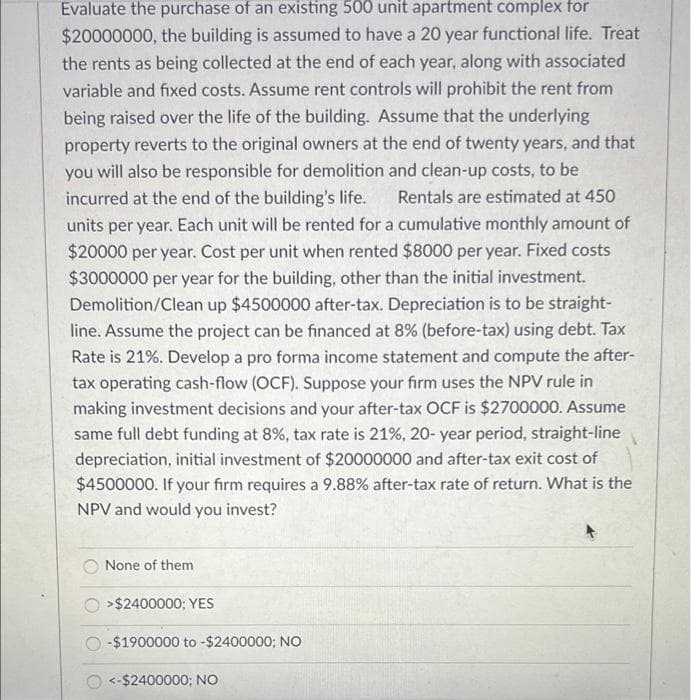Evaluate the purchase of existii $20000000, the building is assumed to have a 20 year functional life. Treat the rents as being collected at the end of each year, along with associated variable and fixed costs. Assume rent controls will prohibit the rent from being raised over the life of the building. Assume that the underlying property reverts to the original owners at the end of twenty years, and that you will also be responsible for demolition and clean-up costs, to be incurred at the end of the building's life. Rentals are estimated at 450 units per year. Each unit will be rented for a cumulative monthly amount of $20000 per year. Cost per unit when rented $8000 per year. Fixed costs $3000000 per year for the building, other than the initial investment. Demolition/Clean up $4500000 after-tax. Depreciation is to be straight- line. Assume the project can be financed at 8% (before-tax) using debt. Tax Rate is 21%. Develop a pro forma income statement and compute the after- tax operating cash-flow (OCF). Suppose your firm uses the NPV rule in making investment decisions and your after-tax OCF is $2700000. Assume same full debt funding at 8%, tax rate is 21%, 20- year period, straight-line depreciation, initial investment of $20000000 and after-tax exit cost of $4500000. If your firm requires a 9.88% after-tax rate of return. What is the NPV and would you invest? None of them >$2400000; YES -$1900000 to -$2400000; NO O <-$2400000; NO
Evaluate the purchase of existii $20000000, the building is assumed to have a 20 year functional life. Treat the rents as being collected at the end of each year, along with associated variable and fixed costs. Assume rent controls will prohibit the rent from being raised over the life of the building. Assume that the underlying property reverts to the original owners at the end of twenty years, and that you will also be responsible for demolition and clean-up costs, to be incurred at the end of the building's life. Rentals are estimated at 450 units per year. Each unit will be rented for a cumulative monthly amount of $20000 per year. Cost per unit when rented $8000 per year. Fixed costs $3000000 per year for the building, other than the initial investment. Demolition/Clean up $4500000 after-tax. Depreciation is to be straight- line. Assume the project can be financed at 8% (before-tax) using debt. Tax Rate is 21%. Develop a pro forma income statement and compute the after- tax operating cash-flow (OCF). Suppose your firm uses the NPV rule in making investment decisions and your after-tax OCF is $2700000. Assume same full debt funding at 8%, tax rate is 21%, 20- year period, straight-line depreciation, initial investment of $20000000 and after-tax exit cost of $4500000. If your firm requires a 9.88% after-tax rate of return. What is the NPV and would you invest? None of them >$2400000; YES -$1900000 to -$2400000; NO O <-$2400000; NO
Chapter11: Long-term Assets
Section: Chapter Questions
Problem 15PB: Urquhart Global purchases a building to house its administrative offices for $500,000. The best...
Related questions
Question
3

Transcribed Image Text:Evaluate the purchase of an existing 500 unit apartment complex for
$20000000, the building is assumed to have a 20 year functional life. Treat
the rents as being collected at the end of each year, along with associated
variable and fixed costs. Assume rent controls will prohibit the rent from
being raised over the life of the building. Assume that the underlying
property reverts to the original owners at the end of twenty years, and that
you will also be responsible for demolition and clean-up costs, to be
incurred at the end of the building's life.
Rentals are estimated at 450
units per year. Each unit will be rented for a cumulative monthly amount of
$20000 per year. Cost per unit when rented $8000 per year. Fixed costs
$3000000 per year for the building, other than the initial investment.
Demolition/Clean up $4500000 after-tax. Depreciation is to be straight-
line. Assume the project can be financed at 8% (before-tax) using debt. Tax
Rate is 21%. Develop a pro forma income statement and compute the after-
tax operating cash-flow (OCF). Suppose your firm uses the NPV rule in
making investment decisions and your after-tax OCF is $2700000. Assume
same full debt funding at 8%, tax rate is 21%, 20- year period, straight-line
depreciation, initial investment of $20000000 and after-tax exit cost of
$4500000. If your firm requires a 9.88% after-tax rate of return. What is the
NPV and would you invest?
None of them
>$2400000; YES
-$1900000 to -$2400000; NO
<-$2400000; No
O O
Expert Solution
This question has been solved!
Explore an expertly crafted, step-by-step solution for a thorough understanding of key concepts.
This is a popular solution!
Trending now
This is a popular solution!
Step by step
Solved in 3 steps with 3 images

Recommended textbooks for you

Principles of Accounting Volume 1
Accounting
ISBN:
9781947172685
Author:
OpenStax
Publisher:
OpenStax College


Intermediate Accounting: Reporting And Analysis
Accounting
ISBN:
9781337788281
Author:
James M. Wahlen, Jefferson P. Jones, Donald Pagach
Publisher:
Cengage Learning

Principles of Accounting Volume 1
Accounting
ISBN:
9781947172685
Author:
OpenStax
Publisher:
OpenStax College


Intermediate Accounting: Reporting And Analysis
Accounting
ISBN:
9781337788281
Author:
James M. Wahlen, Jefferson P. Jones, Donald Pagach
Publisher:
Cengage Learning


